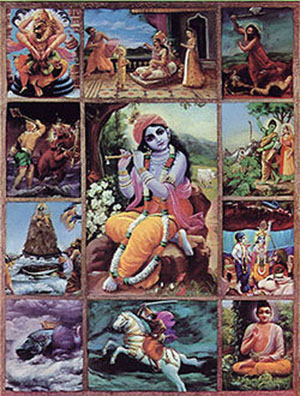|
|
Moksha
What will I become?

|
Throughout the study of Hinduism, one finds its cosmology fraught with the suffering and anguish that is the wheel of samsara; its justice is found in humanity’s ability to overcome this cycle. This is the notion of moksha and it explains how liberation can be attained by fulfilling one’s duty and obligations (dharma), prescribed by one’s place in life (ashrama). In the story of Ramayana, Rama is the 7th avatar of the Hindu deity Vishnu; an avatar is a human manifestation of the divine essence (Brahman). The image to the left reflects the ten avatars of the deity Vishnu with the 10th and final incarnation represented by the Kalki on the white horse (the image directly below the central image of Krishna playing the flute). As mentioned earlier, Rama's duties follow from being a member of the Kshatriya class as prince of Ayodhya. Although he is Vishnu's avatar he does not yet have full knowledge of his abilities and powers. In Hinduism, it is believed that Vishnu reincarnates when humanity fails to meet its dharma to serve as a model for right behavior.
|
 |
In embracing this duty and its respective obligations one moves toward liberation; the state of one’s soul is central to this. Rama & Sita embody the avatars of Vishnu & Lakshmi in an effort to raise humanity’s dharma. Some may reflect on how the struggle to overcome moral dilemmas is a move to establish cosmic justice on the part of the deities. As such, liberation as a theme in Ramayana is not seen as a linear goal but as a succession of karma/dharma fulfillment in the service of others. As we find in the conclusion of the story, in order to find the "other" one must sacrifice the "self" in service to one's dharma irrespective of the maya (illusion) of pleasure and power.
As a secondary item of interest, there is further tension developed between Vaishnavites and Shivites (Rama as Vishnu, Ravana as a Shiva devotee) which shows the heteronomy of Hinduism as a religious tradition. While the Ramayana reflects a Vaishnavite tradition it is not the whole narrative for Hindus who recognize the social and cultural particularities within this historically rich religious tradition.
|
|

